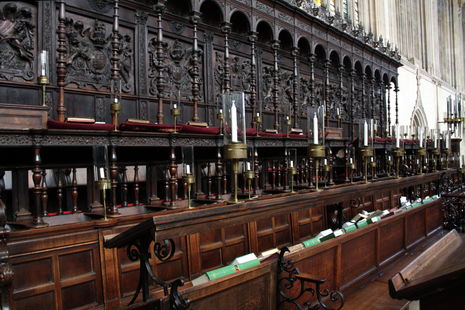The unsung heroines of Cambridge college choirs
Lara Cort examines the place of women in Cambridge college choirs, and asks if some traditions are better left in the past

On 15th October 2021, St John’s College proudly announced that it would be accepting women in its internationally renowned choir. Not only would this be the first Oxbridge choir to have both child and adult, male and female singers, but the decision broke a 350 year old tradition of an all-male choir at John’s. Making national news headlines, the announcement came with huge support both in Cambridge and around the rest of the UK. But at a university where women have been members for nearly eighty years, why are there still spaces where we are not allowed?
From the moment you unpack your bags in Cambridge, you are surrounded by traditions. They are one of the quirks of Cambridge – usually harmless nonsense that provides a good anecdote for people back home to laugh about. At worst, they result in stuffy, time-consuming events where you have to wear a slightly uncomfortable outfit. One of the longest running traditions at Cambridge is the college choir. Harking back to Cambridge’s ecclesiastical past, they were established to provide music for the college, alongside opportunities for singers and composers to practise their craft. Choirs offer students rich extracurricular experiences, with many travelling abroad during the long summer vacation, alongside unique performance opportunities – including singing at the top of the St John’s College Chapel tower, or the annually broadcast Carols from King’s.
“They are one of the quirks of Cambridge; usually harmless nonsense that provides a good anecdote”
However, some of these choral traditions seem to be characterised by their distinct lack of women. As the result of a centuries-old belief that women should not be allowed to sing in church (often attributed to a misinterpretation of a quote by St Paul), castrati singers or choirboys were traditionally employed to sing the higher voice parts. Now, only three choirs have child choristers: King's College Choir, The Choir of St John's and the Chapel Choir of Jesus College. Two of them (King's and John's), have dedicated schools where choristers are taught alongside other children, and all three colleges have a ‘secondary’ mixed choir, which sings fewer services and to a lesser musical standard.
What this practically meant was that trained female singers in these colleges were (and sometimes still are), stuck under a glass ceiling – while music tuition, resources and opportunities passed over them en-route to children and male countertenors. Where it still happens, the maintenance of this long-standing tradition comes at the exclusion of a group that makes up half of the student body. And while there is progress taking place, in some colleges there remains a lack of enthusiasm and interest in incorporating women into their musical frameworks.
The 2021 decision to accept women into St John’s' choir allowed two girl choristers and a woman singer. When describing her time singing in the choir, Nina Vinthers – the first woman singer – looks back on fond memories. She remembers a “supportive environment” where she was quickly integrated into the choir, being given solos from the very start so as not to not feel like “the odd one out”. This was, in many ways, an unfamiliar feeling: she started singing before university in St Albans Abbey Girls Choir (which had a male equivalent), and describes how she felt secondary to the boys: “I felt a bit like the B team, and the boys were on the A team. Of course that’s not what the adults intended, but children have a strong sense of what feels like injustice.” Opening up the Choir of St John's symbolised not only to those watching, but also to those within, that women are equal to their male counterparts, from child chorister to adult singer.
“A male-only choir seems to be the antithesis of the values of both King’s College and its Chapel”
The same change is yet to happen at King's. With its female provost, lack of a dress code and frequent diverse readings, a male-only choir seems to be the antithesis of the values of both King’s College and its Chapel. Yet, women are still only allowed to join King’s Voices (KV), the secondary choir. Last year this choir was permitted to use the Chapel twice per week – once for rehearsal and once for Evensong. Now the choir only sings on Evensong days and instead rehearses in a room known for its ‘famously bad acoustics’ and out of tune piano. As a ‘treat’, KV is sometimes permitted to sing with the all-male King’s College Choir (KCC); however, this is often reserved for particularly significant performances. As the secondary choir at the College, it is typical that less opportunities and expenses are given. However, when this choir is the highest level that female singers can progress to in the college, the lack of resources has pointed implications. Differences in treatment between the choirs in terms of formal performance attire (cassocks), presentation of music, rehearsal and performance space, feel no less symbolic than the choice to equalise opportunities at John’s: at King's, the spaces that women can occupy are made to feel less than, while at the same time any opportunities for advancement are prohibited.
Amy, a female choral scholar in KV, is acutely aware of this. She describes feeling that she doesn’t get “taken seriously” as a female choral scholar, and that conversations she has had have currently amounted to no changes for the choir. She recalls a previous event where the premier of a piece written by a noteworthy female composer (and KV alumna) was cut short. It was a concert combining both KV and KCC; while KV had rehearsed the piece in full, a lack of alloted rehearsal time with the two choirs together meant that the whole piece was not performed in full. To Amy, “missing out so much” of the music for a premiere (the first time a composition is performed live) did not feel right – and suggested a lack of recognition to women participating in music, both in the past and present. Amy’s feelings echo Nina’s earlier experiences in the choral world: she describes trying to succeed in a place where she was “not invited”, that was “not built for women”.
“Entrenched misogyny called tradition”
The international reputation of King’s College Choir may conflate it with other independent professional ensembles. However, as part of a College where students both live and work, the Choir should be representative of the body of individuals it serves - something it does not currently achieve through its exclusion of women. Ironically, through an attempt to preserve tradition, the Choir has lost sight of its traditional purpose: to provide music “for the college”, and musical opportunities to its members. Within a mixed college, Amy argues that the frequent counterarguments she encounters defending King’s College Choir as “traditional” seem out of place, and more like “entrenched misogyny called tradition”.
John’s has demonstrated the potential for change: Amy suggests that a phased approach (mimicking that of John’s) would be respectful to the existing members of the choir, without taking away their opportunities, while also mediating the “global reputation” of King’s College Choir. It would create the chance for more stories like Nina’s. Memorably, Nina talked to me not only about the musical opportunities John’s had provided for her, but also about the chance she had been provided to help others: “I especially loved teaching the choristers at the school … and I think the girls really valued having a recognisable role model on the back row.” Amy has no illusions that change will take time, and doesn’t foresee being able to join KCC herself – but describes that she “[wants] it to be an option for everyone.”
While years of practice and support lies behind them, at some point we must ask ourselves why certain traditions in Cambridge are still ongoing. The classical music scene is diversifying, but still notoriously difficult for many different types of people to permeate; this is one tradition that should soon reach its end.
Names of interviewees have been anonymised in this article and interviews were conducted between the 5th and 13th of January
 News / Clare Hall spent over £500k opposing busway 24 December 2025
News / Clare Hall spent over £500k opposing busway 24 December 2025 Comment / The ‘class’ of Cambridge24 December 2025
Comment / The ‘class’ of Cambridge24 December 2025 News / Caius mourns its tree-mendous loss23 December 2025
News / Caius mourns its tree-mendous loss23 December 2025 Comment / League tables do more harm than good26 December 2025
Comment / League tables do more harm than good26 December 2025 News / Girton JCR publishes open letter expressing solidarity with Palestine25 December 2025
News / Girton JCR publishes open letter expressing solidarity with Palestine25 December 2025









